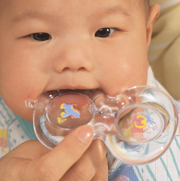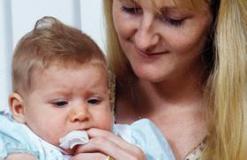Teething and your baby
Baby teeth
Healthy baby teeth allow a toddler to enjoy a nutritious diet, aid in proper speech development, enhance the child’s appearance and contribute to good self-esteem.
Baby teeth also help to maintain the space for permanent teeth, guiding them into their correct position.
Early loss of a baby tooth can reduce the space for the permanent tooth, resulting in crowded permanent teeth.
Teething
A baby’s first tooth usually appears at around 6 months, however this can vary greatly.
By the age of 3 a child should have a full set of 20 baby teeth (10 in each jaw).
Table: General guide of when baby teeth appear
| Tooth type |
Age |
|
Central incisors
|
6 to 10 months
|
|
Lateral incisors
|
10 to 16 months
|
|
Canine
|
17 to 23 months
|
|
1st baby molar
|
14 to 18 months
|
|
2nd baby molar
|
23 to 31 months
|
It is not uncommon for babies to experience some discomfort when new teeth break through the gums.
Teething signs and symptoms
Symptoms that indicate your baby may be teething include:

- red swollen gums
- flushed cheeks
- dribbling
- irritability or restlessness
- a slight fever
- pulling the ear on the same side as the erupting tooth
- sucking fingers and fists.
Mild teething problems may be eased by the baby chewing on hard objects such as chilled teething rings or sugar free rusks.
Alternatively you can give your baby a dummy or wet flannel to bite on. It may also help to rub your child’s gums with a clean finger or the back of a cold spoon.
See your dentist or doctor before using any pain reliever or oral gel containing anaesthetic, or if problems persist.
Cleaning baby’s mouth
 Start cleaning gums before the teeth appear.
Start cleaning gums before the teeth appear.
At first, use a clean damp cloth to wipe the gums, and when a few teeth are present use a small, soft toothbrush with no toothpaste.
When your child is 18 months, you can use a small pea-sized amount of low strength fluoride toothpaste.
If your child is 6 or over, use a small amount of standard strength fluoride toothpaste and encourage your child to spit out, not swallow and not rinse after brushing.

Where to get help
Dental Health Services
You can also
Remember
- Baby teeth are important, so take good care of your child's teeth.
- Teething should not cause severe illness. If your child has a fever or diarrhoea, see your doctor.
- Avoid choking by always being present when your child is eating.
- A low fluoride toothpaste is recommended for children under 6 years.
Acknowledgements
Dental Health Services
This publication is provided for education and information purposes only. It is not a substitute for professional medical care. Information about a therapy, service, product or treatment does not imply endorsement and is not intended to replace advice from your healthcare professional. Readers should note that over time currency and completeness of the information may change. All users should seek advice from a qualified healthcare professional for a diagnosis and answers to their medical questions.